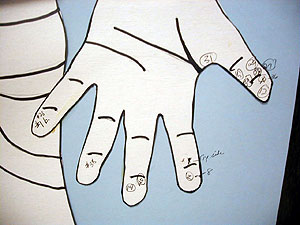|
Audio
Photos
Resources
Your Voice
|
Hurt by hooks
August 31, 2003
Anglers in Minnesota have plenty of tales about the fish they caught. They probably have many more about the ones they didn't. But for some, the memories are not hooking a fish, but how they hooked themselves. Most times getting stuck with a fish hook is a minor nuisance, but it can mean a trip to the emergency room. In the central Minnesota town of Alexandria, people in the ER have found a creative way to keep track of fish hook incidents.
Alexandria, Minn. — The doctors and nurses at the Douglas County Hospital in Alexandria are getting pretty good at removing fish hooks.
Alexandria is a resort town surrounded by lakes, so during the summer a steady stream of anglers come in the door with a hook stuck somewhere in their body.
 | |||
"A lot of them are in fingers, a lot are in the back of the head or the back of the body. They're all over," says Kevin Weedman, the emergency room manager.
For as long as anyone here can remember, folks in the ER have kept track of the grisly details of fish hook accidents. They write down the lake where the hooking occurred and where the person is from. Then they walk over to a life-sized cutout of a human body, dressed as an angler, and mark where the hook was stuck.
This isn't some kind of awareness campaign to warn people of the danger of fish hooks -- that's just a hazard of fishing. Weedman say the purpose is to let people stuck by a hook know they're not alone.
"People come in feeling foolish or embarrassed, saying, 'I got a fish hook.' Weedman says. "We say, 'That's fine,' and they stop and look where everyone else got hooked."
Weedman says they start keeping track of hook injuries during the fishing opener in May. This season's been charted on the life-sized picture of the angler.
 | |||
"Half of them are on the hands and fingers. About seven in the face area, lip, ears, back of the head," he ticks off the injuries. "One in the eyelid, one on the chin. We had a couple on the arms, one on the knee and a few on the back."
Weedman says they teach each of their patients how to remove hooks to prevent a return visit. He says it's easy and painless, and most times doesn't require a trip to the emergency room.
"You take a loop of string, about six inches or eight inches, in a circle. You put the string around the hook, and you pull the fishhook down and forward to disengage the barb, and then you take a quick jerk. Most of the time they come out the same hole they went in," Weedman says.
The nurses and doctors here at the Douglas County Hospital will keep track of the fish hooks they remove for a few more weeks.
The tally so far this summer sits at 55. For the record, the most they've have to remove in one summer is 68.
|
News Headlines
|
Related Subjects
|

